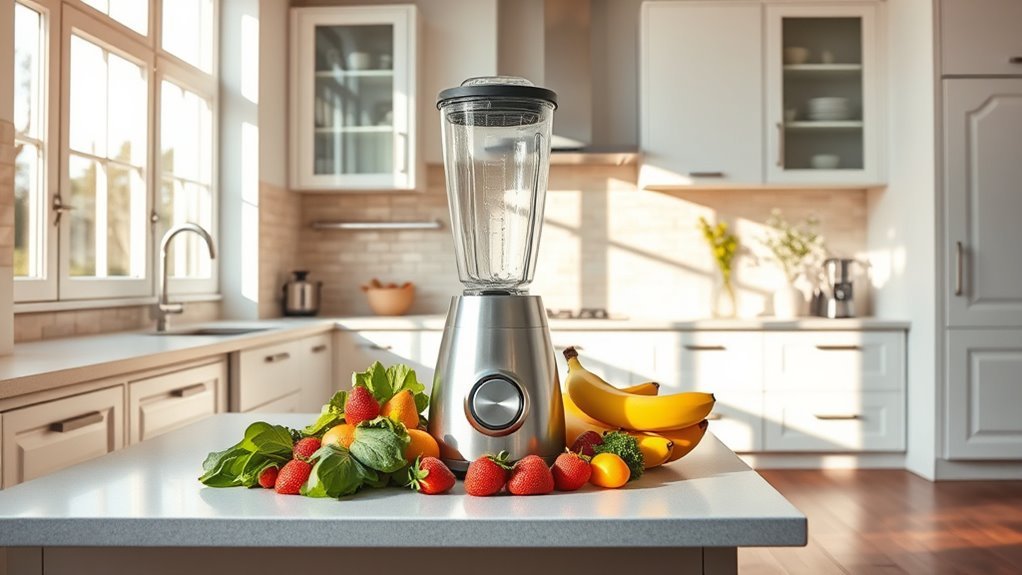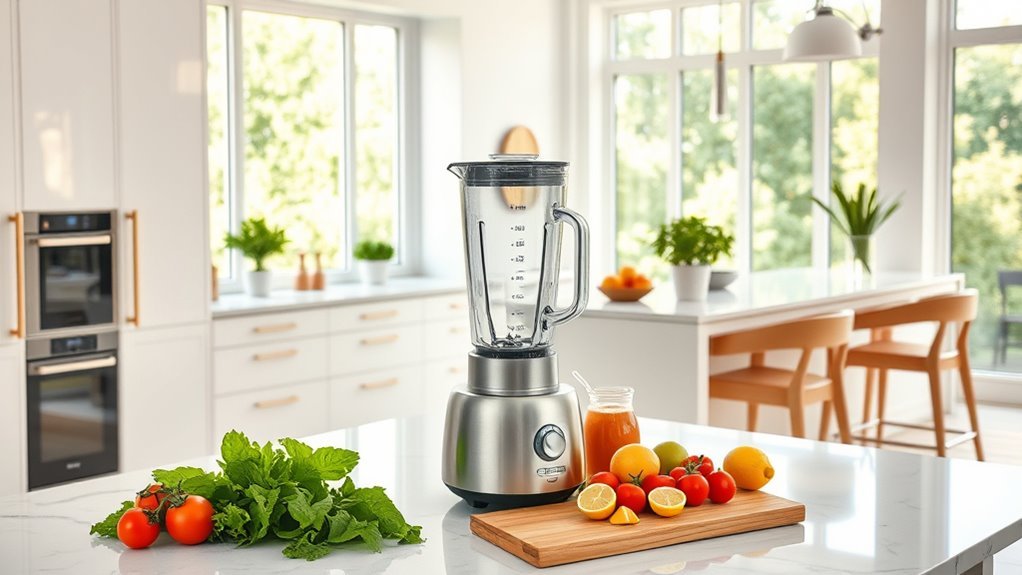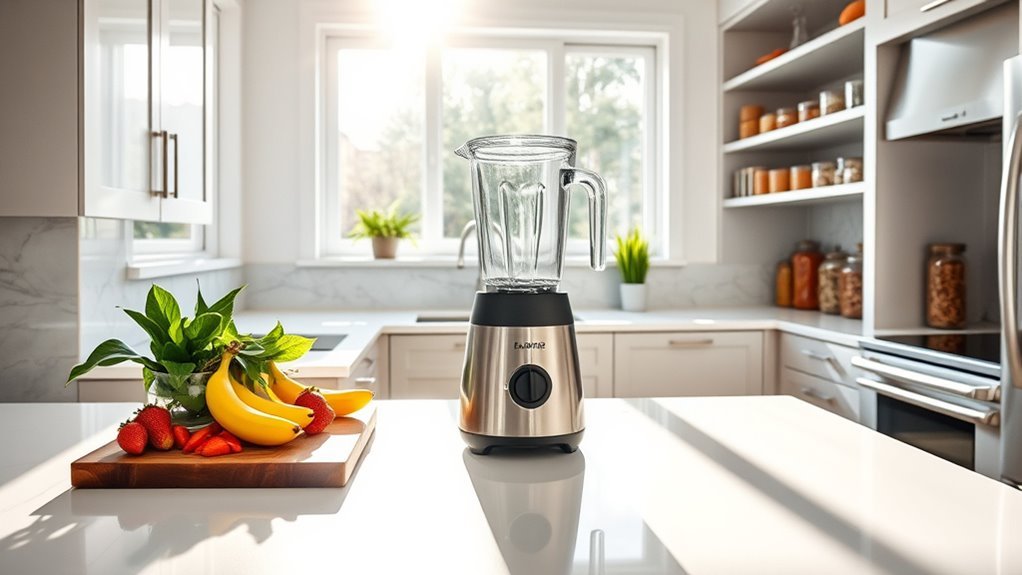We can’t stress this enough: safe blender blade cleaning prevents serious injuries and extends appliance life. Those sharp edges cause 8,000 kitchen accidents yearly in the U.S. – mostly from rushed cleaning and bare-handed scrubbing. Proper maintenance with the right tools keeps blades razor-sharp while protecting your fingers. Smart cleaning also prevents bacterial growth and cross-contamination. Let’s explore the essential safety protocols that’ll keep your blending adventure accident-free.
Essential Safety Precautions Before Cleaning Blender Blades

While cleaning blender blades might seem straightforward, one wrong move can land you in the emergency room. When cleaning the blender, we’ve got to exercise caution at every step – no exceptions.
Let’s start with the non-negotiables: Always unplug before you even think about cleaning those blades. Trust us, a powered-on blender is a disaster waiting to happen.
Next up, personal protective equipment (PPE). Grab those gloves and goggles – your fingers and eyes will thank you later.
Whatever you do, avoid using hands to reach into that jar. Instead, use a long-handled brush to clean your blender blades.
And here’s a critical step many forget: Detach that jar from the base completely. Those blades can slice you even when they’re not moving. Using a high-performance blender can enhance your kitchen experience, as they are designed with enhanced safety features that help minimize accidents during cleaning.
Proper Tools and Equipment for Safe Blade Maintenance
Since we’re dealing with razor-sharp blades, let’s get your toolkit right. Proper tools aren’t just about convenience – they’re essential for safe blade maintenance and your personal safety.
We’ve tested countless methods, and here’s what actually works for peak blender efficiency and hygiene.
- Long-handle brush specifically designed for cleaning blenders – keeps your hands safely away from those menacing blades
- Non-abrasive scrubber or small brush for tackling stubborn residue without damaging the blade surface
- Damp cloth with dish soap for the base unit – because water and electrical components don’t play nice
- Dedicated cleaning tools stored separately from regular kitchen items – prevents cross-contamination and guarantees you’ll always have the right tool for safe maintenance.
Additionally, maintaining your blender can extend its lifespan, as proper care is crucial for ensuring smooth blending for years.
Step-by-Step Guide to Cleaning Blades Without Injury

Now that you’ve got your cleaning arsenal ready, let’s break down the safest way to tackle those razor-sharp blades.
First, unplug that blender – no exceptions. We’re not risking any surprise spin-ups while cleaning your blender.
Rinse immediately after use – it’s not laziness, it’s strategy. Hardened residue means more dangerous scrubbing later.
For stubborn gunk, let those blades soak in warm, soapy water for a few minutes. Don’t rush it.
Grab your long-handle brush or specialized cleaning tool – your fingers have no business near those edges.
Keep a safe distance while scrubbing. Think of it as a dance: you lead, the blades follow, but never get too close.
A clean blender is great, but intact fingers are better.
Common Mistakes That Lead to Blade Cleaning Accidents
Despite our best intentions, blender cleaning mishaps happen when we let our guard down.
We’ve seen countless accidents that could’ve been prevented with proper safety protocols. Let’s tackle the most dangerous mistakes head-on.
- Leaving the blender plugged in while cleaning – this rookie move risks accidental activation and serious injury when your hands are near the blades.
- Using bare hands to clean sharp edges instead of proper tools – those blades mean business and won’t hesitate to slice.
- Skipping manufacturer cleaning guidelines – they’re written in blood (figuratively) and exist for your safety.
- Cleaning without a long-handled brush – keeping distance from blender blades isn’t cowardice, it’s common sense.
Remember: rushed blade cleaning leads to emergency room visits.
Take the extra minute – your fingers will thank you.
Professional Tips for Stubborn Residue Removal

When stubborn residue turns your blender into a science experiment gone wrong, we’ve got the professional-grade solutions you need.
Start with our foolproof soapy water trick: blend warm water with dish soap for one minute. It’s like magic for breaking down gunk without risking your fingers.
For those truly stubborn spots, we’re not messing around. Grab a long-handle brush – your hands will thank you later.
Still fighting back? Hit it with a vinegar soak to dissolve those mineral deposits. For next-level stains, our baking soda paste treatment works wonders (just keep it away from those blades).
Here’s the real pro secret: regular maintenance is your best friend. Clean the blender right after use, every time. No exceptions.
Trust us – prevention beats wrestling with dried-on smoothie any day.
Long-Term Blade Care Strategies for Optimal Performance
Three key strategies form the backbone of professional-grade blade maintenance.
We’ve learned that consistent care dramatically extends blade life while ensuring peak performance.
Let’s tackle the essentials of blender maintenance with these battle-tested approaches that’ll keep your machine running like new.
- Implement immediate post-use cleaning with warm, soapy water – don’t let food residue cement itself to the blades.
- Use a long-handle brush for safe, thorough cleaning, even if your blender claims to be dishwasher safe.
- Schedule weekly deep-cleaning sessions to prevent buildup in hard-to-reach areas.
- Rotate between soaking and gentle cleaning methods, avoiding harsh chemicals that could compromise blade integrity.
Remember: A clean blade is a sharp blade.
We’re not just maintaining equipment – we’re protecting our investment in kitchen excellence.
Frequently Asked Questions
What Is the Safe Handling Technique for Blender?
We’ll save you from a million mishaps! Let’s unplug first, wear protective gloves, carefully disassemble, clean with gentle solutions, inspect blades regularly, and store safely away from reach.
How Do You Clean a Blender Blade Safely?
We’ll unplug first, then disassemble using manufacturer’s guidelines. Use warm soapy water and long-handled brushes for maintenance. Run quick cleaning cycles with dish soap for stubborn residue, avoiding direct blade contact.
What Are the Safety Precautions to Be Observed in Cleaning a Blender?
We’ll need to unplug first, wear protective gloves, carefully disassemble the blender, use proper detergents, and clean blades with long-handled brushes to avoid cuts during routine maintenance.
What Are the Specific Points of Care When Cleaning Blenders?
We’ll want to clean blades daily, using soft brushes and avoiding wire scrubbers. Let’s store blenders disassembled, maintain stainless steel properly, and never submerge bases. Regular cleaning prevents bacterial growth.

